Overview of the 13th Edition
The 13th Edition of the Human Anatomy and Physiology Lab Manual, authored by Elaine Marieb and Lori Smith, offers a comprehensive resource for anatomy and physiology studies. Updated with full-color visuals, revised clinical questions, and a structured organization aligned with textbook chapters, it enhances learning both in and out of the lab. This edition integrates seamlessly with Mastering A&P, providing a robust toolkit for students in healthcare and STEM fields.
Authors and Publishers
The Human Anatomy and Physiology Laboratory Manual, 13th Edition, is authored by Elaine Nicpon Marieb and Lori A. Smith. Elaine Marieb, a renowned anatomist and educator, has contributed significantly to anatomy and physiology education. Lori Smith brings extensive experience in developing educational resources for healthcare and STEM fields. The manual is published by Pearson, a leading educational publisher, ensuring high-quality content and widespread accessibility. This edition, released in 2018, is part of Pearson’s commitment to providing cutting-edge educational materials. The collaboration between Marieb and Smith ensures a comprehensive and student-focused approach, making the manual a trusted resource for anatomy and physiology education.
Key Features of the 13th Edition
The 13th Edition of the Human Anatomy and Physiology Laboratory Manual features numerous enhancements to enrich the learning experience. It includes new, full-color figures and photographs that provide clearer visual representations of anatomical structures. The manual also boasts revamped clinical application and critical thinking questions, encouraging students to connect theoretical knowledge with real-world scenarios. Additionally, the organization of lab exercises aligns with textbook chapters, ensuring a structured and cohesive learning path. The integration with Mastering A&P, Pearson’s online learning platform, offers additional resources such as interactive activities and assessments. These features collectively aim to improve understanding, retention, and practical application of anatomy and physiology concepts, making the manual an indispensable tool for students in healthcare and STEM fields.

Structure and Content
The manual is organized into clear sections, focusing on skeletal, muscular, and organ systems. It includes detailed dissection guides and practical exercises, aligning with textbook chapters for structured learning.
Organization of the Lab Manual
The 13th Edition of the Human Anatomy and Physiology Lab Manual is meticulously organized to align with textbook chapters, ensuring a logical flow of content. It begins with an overview of the human body before delving into specific systems, such as skeletal, muscular, and organ systems. Each chapter includes detailed dissection guides, practical exercises, and clinical application questions to enhance understanding. The manual is available in three versions—Cat, Fetal Pig, and Main—each tailored to specific lab needs. Exercises are clearly indexed, with dissection steps and anatomical illustrations to aid visualization. The spiral-bound format allows for easy use in lab settings, while the alignment with Mastering A&P facilitates online learning integration. This structured approach ensures students can follow along seamlessly, making it an indispensable resource for anatomy and physiology coursework.
Main Sections and Exercises
The 13th Edition of the Human Anatomy and Physiology Lab Manual is divided into clear sections, each focusing on specific anatomical systems. Key exercises include detailed dissection guides for cat and fetal pig versions, with step-by-step instructions and high-quality images. Practical experiments, such as measuring physiological parameters, reinforce theoretical concepts. Clinical application and critical thinking questions are integrated throughout, encouraging students to connect lab work with real-world scenarios. Additionally, histology and microscopy exercises provide hands-on experience with cellular structures. The manual also includes activities on surface anatomy and imaging techniques, such as X-rays and MRIs, to enhance understanding of internal structures. These comprehensive exercises cater to diverse learning styles, ensuring students develop both tactile and analytical skills essential for healthcare and STEM careers. The structured progression of exercises builds foundational knowledge, preparing students for advanced studies and professional applications.
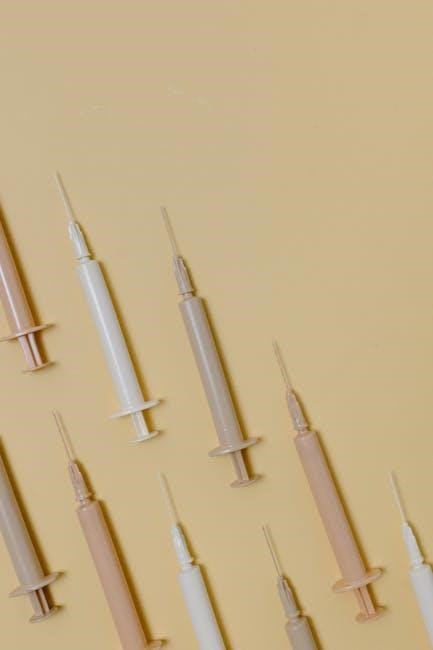
Lab Exercises and Activities
The 13th Edition includes a variety of lab exercises, such as dissection guides for cats and fetal pigs, practical physiological experiments, and clinical application questions for real-world relevance.
Dissection Guides
The 13th Edition provides detailed dissection guides for both cat and fetal pig specimens, offering step-by-step instructions and full-color illustrations to enhance understanding of anatomical structures. These guides are tailored for students in healthcare programs, such as nursing and physical therapy, to provide practical experience in identifying and exploring tissues and organs. The exercises are designed to complement textbook chapters, ensuring a seamless integration of theoretical knowledge with hands-on practice. Additionally, the manual includes dissection exercises that cover various body systems, allowing students to gain a comprehensive grasp of human anatomy through comparative study. The clear organization and visual aids in the dissection guides make complex anatomical concepts more accessible, fostering both engagement and mastery in the lab setting.
Practical Experiments
The 13th Edition of the Human Anatomy and Physiology Lab Manual includes a wide range of practical experiments designed to reinforce key concepts through hands-on learning. These exercises cover physiological measurements, histological studies, and functional assessments, allowing students to explore the human body’s systems in depth. For example, experiments on blood pressure measurement, nerve response, and muscle physiology provide direct insights into how bodily systems operate. The manual also incorporates clinical application questions, encouraging students to think critically about real-world scenarios. Each experiment is supported by clear instructions, visual aids, and expected outcomes, making it easier for students to conduct and understand the activities. These practical exercises are particularly beneficial for students in healthcare programs, as they bridge the gap between theoretical knowledge and practical application, preparing them for future professional demands in fields like nursing, physical therapy, and medicine.
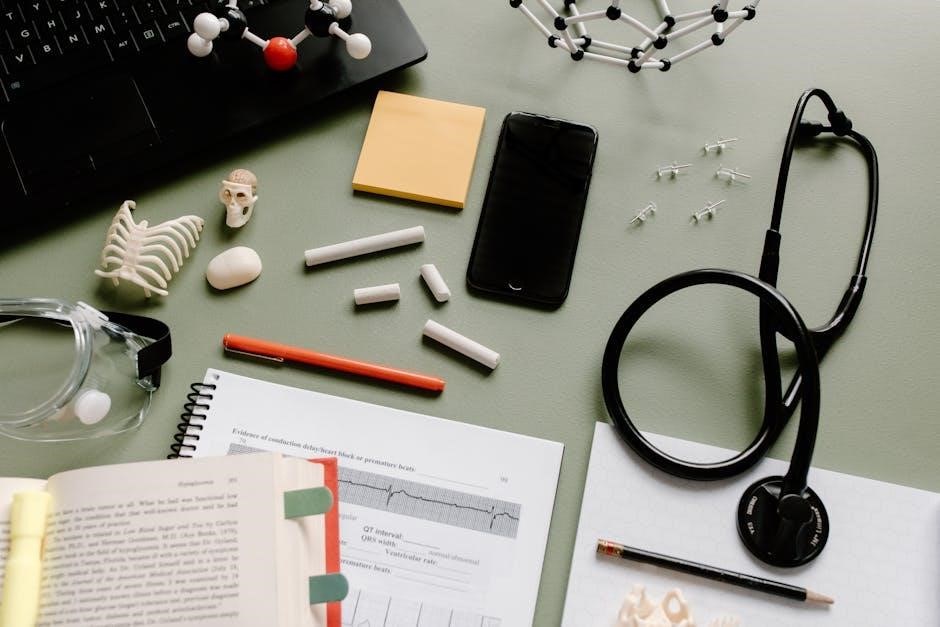
Digital and PDF Versions
The 13th Edition is available in digital and PDF formats, offering flexibility for students to access content on multiple devices. Enhanced with full-color images and interactive features, the digital version complements the print manual, providing an engaging and portable learning experience. Additionally, the PDF version ensures that students can easily reference and annotate material, supporting self-study and collaboration with peers. This format is particularly useful for integrating with online platforms like Mastering A&P, creating a seamless and dynamic learning environment.
Availability and Access
The 13th Edition of the Human Anatomy and Physiology Lab Manual is widely available in both print and digital formats, ensuring accessibility for students worldwide. The manual can be purchased through major bookstores, online retailers, and directly from the publisher, Pearson. Digital versions, including PDF, are accessible via eTextbook platforms, offering flexibility for students to study on various devices. The Cat Version and Fetal Pig Version are particularly popular, with ISBNs provided for easy identification. Additionally, the manual is compatible with Mastering A&P, an online learning platform, enhancing its accessibility and integration into coursework. Students can also rent or buy the manual, depending on their preferences and budget. The availability of multiple formats ensures that learners can access the content in a way that suits their study habits and institutional requirements, making it a versatile resource for anatomy and physiology education.
Benefits of the Digital Format
The digital format of the 13th Edition offers enhanced accessibility and convenience for students. It is available as an eTextbook and PDF, compatible with multiple devices, allowing learners to study anytime and anywhere. The digital version includes interactive features such as search functionality, highlighting, and note-taking tools, which facilitate efficient review and engagement with the content. Additionally, the digital manual integrates seamlessly with Mastering A&P, providing a comprehensive online learning experience. Students can access multimedia resources, including animations and quizzes, to reinforce their understanding of anatomy and physiology. The digital format also reduces the need for physical storage, making it ideal for students who prefer a lightweight and portable study solution. Regular updates ensure that the content remains current, aligning with the latest advancements in the field. Overall, the digital format enhances flexibility, accessibility, and interactivity, catering to diverse learning preferences and modern educational needs.
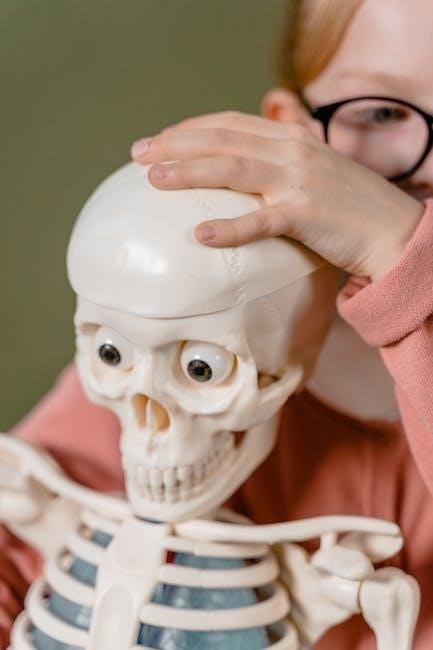
Using the Manual Effectively
Students can maximize the manual by following its structured organization, aligning with textbook chapters for systematic learning. Utilize lab exercises, clinical questions, and digital tools like Mastering A&P for enhanced understanding and time management.
Study Tips for Students
Mastering anatomy and physiology requires consistent effort and effective study strategies. Begin by correlating lab exercises with textbook chapters to build a strong foundation. Use the manual’s full-color visuals and revised clinical questions to enhance understanding. Prioritize reviewing dissection guides and practical experiments before lab sessions to ensure preparedness. Attempt practice questions and critical thinking exercises to reinforce concepts. Utilize the manual’s digital version for flexible access and integration with Mastering A&P, which offers additional interactive resources. Allocate time to explore histological slides and surface anatomy visuals for deeper insight. Regularly review and organize notes, focusing on key structures and functions. Engage in group discussions to clarify doubts and share knowledge. By integrating these strategies, students can optimize their learning experience and achieve success in their anatomy and physiology coursework, especially those pursuing healthcare or STEM fields.
Integration with Other Resources
The 13th Edition of the Human Anatomy and Physiology Lab Manual is designed to seamlessly integrate with other educational resources, enhancing the learning experience. It works hand-in-hand with Mastering A&P, Pearson’s leading online homework and learning program, providing a cohesive platform for assignments and interactive activities. The manual also aligns with the Marieb/Hoehn Human Anatomy & Physiology textbook, ensuring consistency in terminology and presentation. Additionally, it complements digital tools like histological slides and 3D models, offering students a multi-faceted approach to understanding complex concepts. For instructors, the manual integrates with instructor supplements, such as PowerPoint slides and customizable quizzes, to streamline teaching. This holistic integration allows students to access a wealth of resources, reinforcing their understanding of anatomy and physiology through diverse learning modalities.

Relevance to Courses and Professions
The 13th Edition lab manual is a vital resource for students in healthcare and STEM programs like nursing and physical therapy, providing lab experiences essential for professionals.
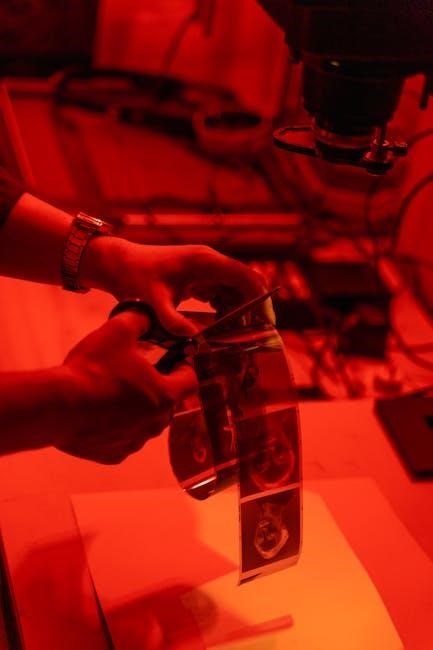
Healthcare Programs
The 13th Edition lab manual is tailored to support students in healthcare programs, including nursing, physical therapy, and respiratory therapy. It provides practical lab experiences that align with the curriculum needs of these fields, offering detailed dissection guides and exercises that enhance understanding of human anatomy and physiology. The manual’s focus on clinical applications and critical thinking questions prepares students for real-world scenarios, making it an invaluable resource for future healthcare professionals. Additionally, its organization corresponds with the Marieb textbook, ensuring a cohesive learning experience for students in these demanding programs. The inclusion of cat and fetal pig dissection exercises further enriches the learning process, catering to diverse healthcare education requirements and fostering proficiency in both theoretical and practical aspects of anatomy and physiology.
STEM and Allied Fields
The 13th Edition of the Human Anatomy and Physiology Lab Manual is a vital resource for students in STEM (Science, Technology, Engineering, and Mathematics) and allied fields, such as biology, pre-med, and exercise science. It provides a robust foundation for understanding human anatomy and physiology through hands-on lab exercises and detailed dissection guides. The manual’s alignment with textbook chapters ensures a cohesive learning experience, while its full-color illustrations and clinical application questions enhance comprehension of complex concepts. For STEM students, the manual’s focus on practical experiments and critical thinking prepares them for advanced studies and research in related fields. Additionally, the inclusion of cat and fetal pig dissection exercises offers a comprehensive learning experience, making it an essential tool for students pursuing careers in science and allied health professions. Its integration with Mastering A&P further enriches the learning journey, fostering academic and professional success.

Teaching and Learning Resources
The 13th Edition provides instructors with robust teaching tools, including lecture slides, customizable labs, and assessment resources. It integrates with Mastering A&P, offering students interactive exercises, quizzes, and virtual labs to reinforce learning. The manual’s clear layout and visual aids make it an excellent resource for both educators and students, ensuring a comprehensive and engaging learning experience.
Instructor Supplements
The 13th Edition provides instructors with a wealth of supplementary materials designed to enhance teaching effectiveness. Lecture slides, customizable lab manuals, and detailed assessment resources are available, offering flexibility in course design. Instructor resources include answer keys, lab setup guides, and customizable quizzes to track student progress. The integration with Mastering A&P further enriches the teaching experience, providing access to virtual labs, interactive simulations, and assignable exercises. These tools empower educators to create engaging and structured lessons tailored to their course needs; The supplements are accessible online, ensuring ease of use and efficient preparation for instructors. By leveraging these resources, educators can foster a dynamic and interactive learning environment, supporting both in-class and online instruction effectively. These supplements underscore the manual’s commitment to aiding both instructors and students in achieving educational success.
Student Support Materials
The 13th Edition of the Human Anatomy and Physiology Lab Manual offers extensive student support materials to enhance learning outcomes. Mastering A&P, the accompanying online platform, provides interactive exercises, virtual lab simulations, and quizzes tailored to reinforce lab content. Students also benefit from study guides, flashcards, and clinical application exercises to deepen their understanding. The manual includes step-by-step dissection guides and colorful illustrations to aid visual learning. Additionally, critical thinking questions encourage students to apply theoretical knowledge to real-world scenarios. The digital version allows access to multi-media resources and self-assessment tools, enabling students to review and practice at their own pace. These materials are designed to support diverse learning styles and provide a comprehensive suite of resources to help students succeed in their anatomy and physiology coursework.
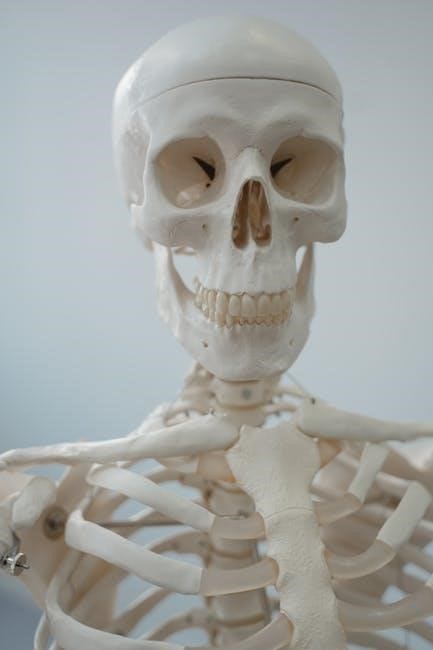
Troubleshooting Common Issues
Common issues with the 13th Edition include PDF access problems and navigation difficulties. Users can resolve these by checking login credentials, ensuring stable internet, and consulting the manual’s support section for guidance.
Accessing the PDF
Accessing the PDF of the Human Anatomy and Physiology Laboratory Manual, 13th Edition is straightforward for registered users. The digital version is available through platforms like Pearson and Amazon, requiring a valid purchase or subscription. Users can download the PDF directly from these platforms after verifying their credentials. Ensure your device meets the system requirements, such as having Adobe Acrobat Reader installed, for smooth access. Institutional access may also be provided through university libraries or learning management systems. If issues arise, such as login problems or download errors, refer to the platform’s support section or contact customer service for assistance. Always verify the authenticity of the source to avoid unauthorized versions. This ensures uninterrupted access to the manual’s resources for effective learning.
Effective Use of the Manual
To use the Human Anatomy and Physiology Laboratory Manual, 13th Edition effectively, students should align their study with the manual’s structured organization. Each lab exercise corresponds to textbook chapters, ensuring a seamless integration of theory and practice. The full-color visuals and updated clinical application questions enhance understanding and critical thinking. For maximum benefit, students are encouraged to complete exercises during lab sessions and review them afterward for reinforcement. The digital version allows for easy access and portability, enabling study outside the lab. Instructors can supplement teaching with the manual’s resources, such as dissection guides and practical experiments. By following the manual’s clear instructions and engaging actively with its content, users can master key concepts in anatomy and physiology, making it an indispensable tool for both classroom and self-study environments.
The 13th Edition of the Human Anatomy and Physiology Lab Manual remains a cornerstone in anatomy education, offering a comprehensive, visually enhanced resource that aligns with modern teaching and learning needs.
Importance in Anatomy Education
The 13th Edition of the Human Anatomy and Physiology Lab Manual is a pivotal resource in anatomy education, providing students with a comprehensive and visually enhanced learning experience. Its organization aligns with textbook chapters, ensuring seamless integration into coursework. The manual’s emphasis on hands-on exercises, dissection guides, and practical experiments fosters a deeper understanding of anatomical structures and physiological processes. By incorporating full-color figures and updated clinical application questions, it bridges theory with real-world scenarios, making it indispensable for healthcare and STEM students. Its alignment with Mastering A&P further enhances its effectiveness, offering a holistic approach to anatomy and physiology education. This edition not only supports traditional lab settings but also caters to modern learning needs, solidifying its role as a cornerstone in anatomy education.
Future of Lab Manuals
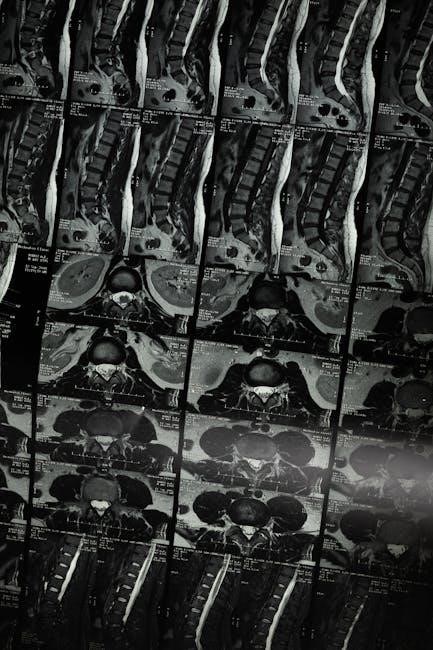
The 13th Edition of the Human Anatomy and Physiology Lab Manual signals a shift toward digital and interactive learning tools. The integration of full-color visuals, revised clinical applications, and critical thinking exercises highlights the evolving nature of lab manuals. As education moves toward hybrid and online formats, lab manuals are increasingly adopting digital platforms, offering accessibility across devices and enhanced learning experiences. The future of lab manuals likely includes more immersive technologies, such as 3D modeling and virtual dissections, to simulate real-world anatomical studies. Additionally, the integration with platforms like Mastering A&P suggests a trend toward personalized learning and real-time feedback. These advancements aim to make anatomy education more engaging, efficient, and adaptable to the needs of modern students. The 13th Edition exemplifies this transition, paving the way for future innovations in anatomy and physiology education.



